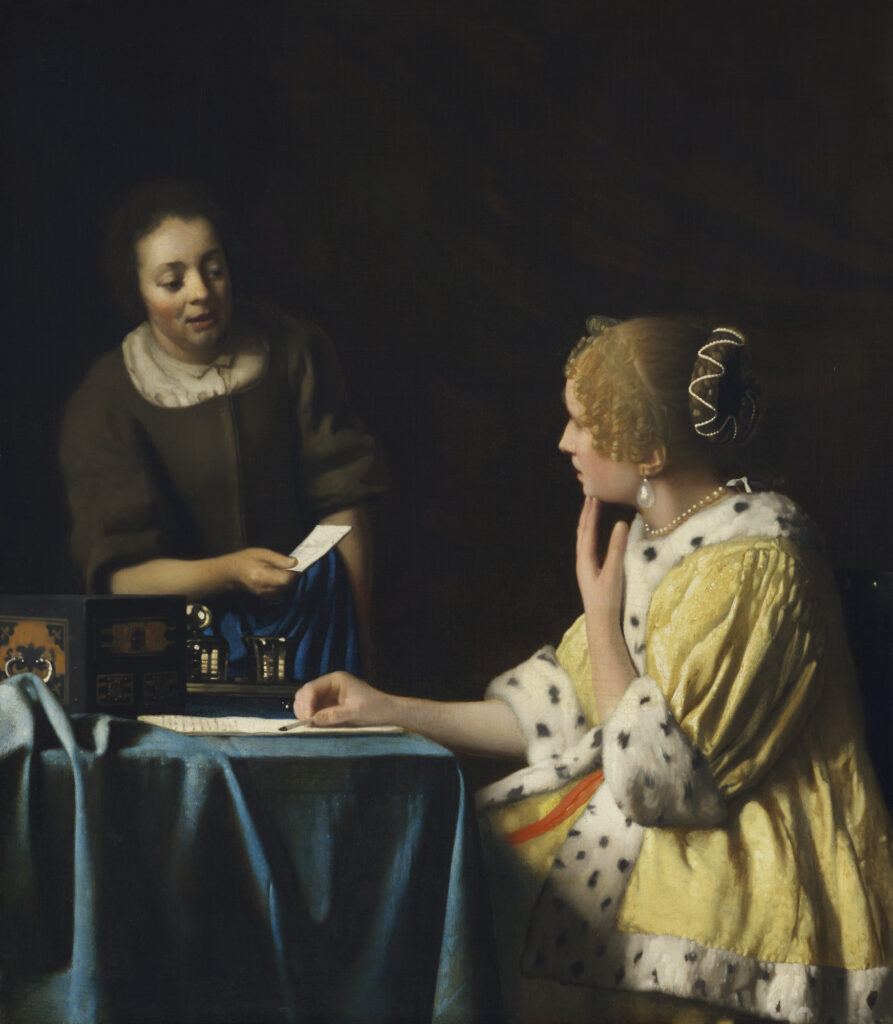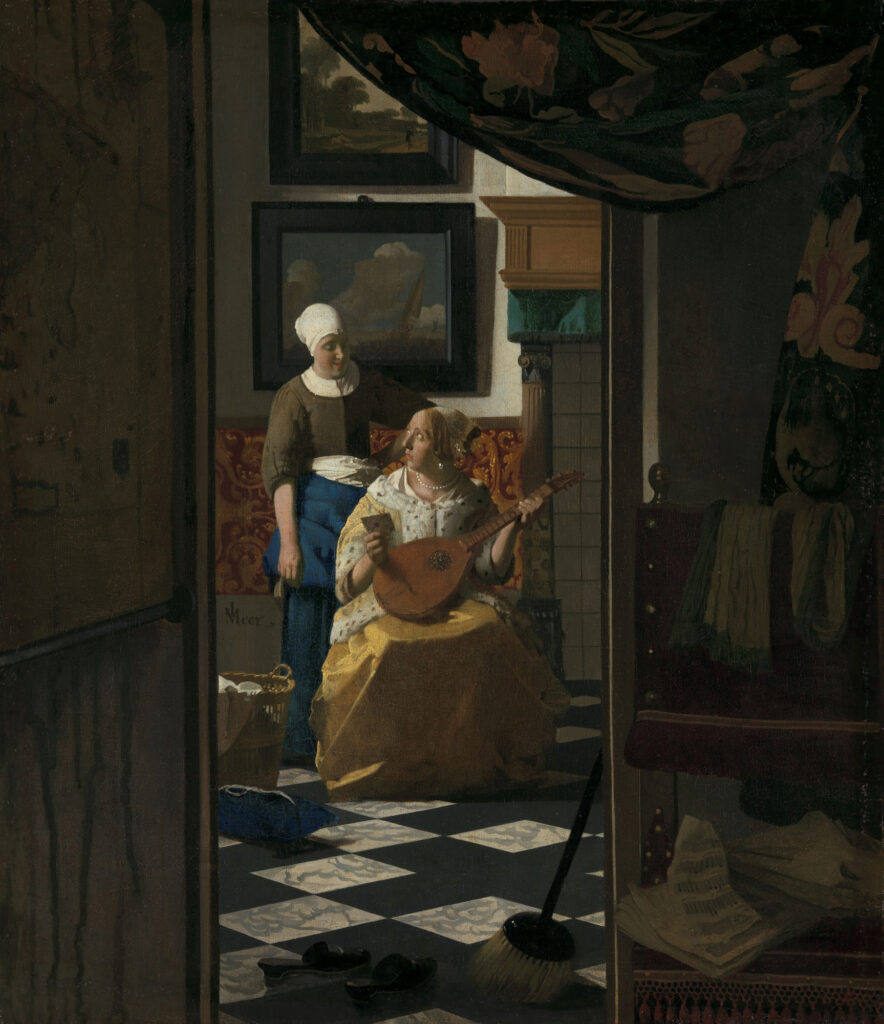Vermeer Comes to the Frick in Full Force
A new show at the renovated collection unites three paintings of writing and wonder.

‘Vermeer’s Love Letters’
The Frick Collection, 1 E. 70th St., Manhattan
Through August 31
Only 36 paintings by Johannes Vermeer are known, making it all the more delicious that the newly renovated Frick Collection has added two works — albeit temporarily — to its horde of three acquired by its founder, Henry Frick, between 1901 and 1919. Every Vermeer is an event, and seeing three side by side is a cause for celebration, especially for those who missed the gathering of 27 Vermeers at the Rijksmuseum in 2023.
Of the three paintings in this show, one did not have to travel. “Mistress and Maid” belongs to the Frick, along with “Officer and Laughing Girl” and “Girl Interrupted at Her Music.” Here on loan are “The Love Letter,” from the Rijksmuseum, and “Woman Writing a Letter With Her Maid,” from the National Gallery of Ireland at Dublin. Five more works by Vermeer reside just a few blocks north, at the Metropolitan Museum of Art.

Vermeer, a 17th century painter who enjoyed only moderate success during his lifetime, is now recognized as one of the crowning glories of the Dutch Golden Age. His paintings are domestic — many are set at home, their scenes evoked with a technique that seems photorealistic even as it retains a numinous edge. Each painting is an eavesdropping, as the viewer happens on a still-unfolding scene. Vermeer used only 20 or so pigments, and no preparatory drawings survive.
A 19th century French art critic, Théophile Thoré-Bürger, called Vermeer the “Sphinx of Delft” for the relative paucity that is known about his life. Baptized in the Reformed Church, he married a Catholic woman, Catharina Bolnes, who would give birth to 15 children. Vermeer died at 43. Bolnes described in a letter to their creditors how he “lapsed into such decay and decadence” that “in a day and a half he went from being healthy to being dead.”
Letters are at the heart of the show at the Frick. They provide an irresistible subject for Vermeer, a poet in paint of a kind of privacy that is nevertheless observed. Letters are as intimate as skin on paper smudged with ink, but also, in Vermeer’s day, they were the ultimate means of remote communication. There was a whole art and decorum to them, and the earliest novels emerged from epistolary exchange. They were ways to keep secrets and share information.

Each painting on display here features not only scenes of letter writing but also two protagonists, a staple of Vermeer’s scenes and engines of enigma. The arithmetic introduces an air of conspiracy or at least collaboration. In each, there is a mistress and a maidservant — there are no men in these paintings, a contrast to the jaunty flirtation that marks “Officer and Laughing Girl.” Still, these three vibrate with tensions of role and class.
These paintings are the 16th century equivalents of a gaggle of women drafting a text message to a crush, except that in each one of Vermeer’s scenes the two women are tasked with serving the other. In “Mistress and Maid” this contrast is sharply drawn, with the mistress sitting down and lavishly dressed in yellow and furs. Vermeer captures a moment of interruption, as the mistress, wearing a large pearl earring, is disturbed in her writing by the delivery of a letter. Her fingers on her chin could signal pensiveness or surprise — has the incoming letter preempted her own?
“The Love Letter” is the smallest painting here, and its scene is glimpsed through a dark passage with household clutter in the foreground. Where “Mistress and Maid” has a wide focus and generous background, the angle in “The Love Letter” is narrow, clipped by a drawn curtain in the painting’s upper right corner. The maid, in an apron and a blue dress, stands next to her mistress, who is playing a popular 17th century instrument, the cittern.
The maid is holding a letter — another scene where receipt of mail is an interruption — and her face conveys concern. The mistress, though, smiles coyly. Historians reckon that the musical instrument and the slippers thrown about on the floor suggest sex and romance. An unused floor brush could signal that domestic duties have given way to more frivolous pursuits. A painting of a stormy sea could mean that the implicit affair is anything but smooth.
“Woman Writing a Letter With Her Maid” is illuminated by the sunlight that pours in from a window on the painting’s left-hand side. The viewer is grateful for the pulling aside of a green curtain. The lady of the house is seated and writing, and a red seal, wax, and some paper lie on the ground. The maid stands behind, and gazes out the window — her task is not to help draft the letter, but presumably to deliver it once it is completed.
The painting, normally at Dublin, carries a colorful history. In 1974 it was stolen — along with a Goya and three Rubens — from the home of an English politician, Sir Alfred Beit. An accomplice was a British heiress turned IRA member, Rose Dugdale. The painting was found eight days later in a cottage in Ireland. It was stolen again in 1986 by a notorious Dublin gangster, Martin Cahill. It was recovered in a sting operation at Antwerp in 1993.
Behind both the lady and her mistress Vermeer has painted a painting within the painting. It is a large depiction of “the Finding of Moses in the River Nile,” an event from Exodus that tells how the future redeemer, afloat in a basket, was detected by the pharaoh’s daughter. The princess exclaims, “This must be a Hebrew child.” He too is a kind of letter, sent from an oppressed people into a cruel world. And he would return to sender with deliverance post haste.

